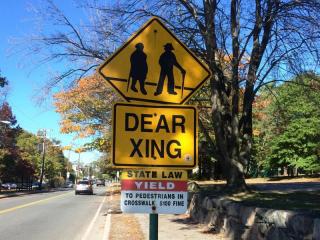Safe Routes for Seniors

Find the Town Safe Routes for Seniors Report here.
In 2010, 1 out of every 5 residents of Weymouth was over the age of 59. By 2020, this number could reach 1 out of every 4. The World Health Organization (WHO) defines healthy aging as “the process of optimizing opportunities for health, participation, and security in order to enhance quality of life as people age.” According to the CDC, regular physical activity - about 150 minutes a week - is a key component of healthy aging. Cities and towns can help older adults move more and achieve this goal by making it easier for seniors to be active in the places they live, gather, and shop.
Seniors and Community Design
Where we live matters greatly to our health. In fact, it is one of the most powerful predictors of diseases such as diabetes, hypertension, and heart disease; diseases that are affected by what we eat and how much we move.
As we age, the impacts of the built environment tend to increase as well. According to one study, “Older adults spend more of their time at home and in their immediate neighborhoods than younger Americans, and as a result, they are more affected by the opportunities and constraints created by the design of their community."[*]
Researchers and urban planners have identified a number of design elements that make it easier and safer for older adults to be active in their communities. These include:
- Wide, unobstructed sidewalks
- Smooth, non-slip walking surfaces
- High-contrast grade changes
- Tight turning radii at intersections
- Accessible curb ramps
- Detectable warning panels at street crossings
- Audible crossing signals
- Extended timers on crossing signals
- Sidewalk extensions
- Street trees and street furniture
- Transit shelters and public restrooms near transit stops
Safe Routes for Seniors Study
In 2014, the Town secured a technical assistance grant through the Massachusetts Department of Public Health to conduct a planning study on "healthy aging through healthy community design" with an emphasis on designing safer routes for seniors. The resulting Safe Routes for Senior study was conducted by the Department of Planning and Community Development in partnership with WalkBoston, a non-profit pedestrian advocacy group, and Healthy Wey, the Town's Mass in Motion Program. The following data sources were used to complete the study:
- Senior pedestrian crashes (2009-2014)
- Motor vehicles crashes (2012)
- Senior housing locations (public, private, and nursing facilities)
- Business, medical, and neighborhood center districts
- Public and semi-public open space locations
- One public forum at Weymouth's senior center
- Four senior pedestrian target areas
- Four street-level walk audits (one in each target area)
The study's final report was published in October 2014. It identifies areas of strength in the Town's infrastructure, areas of opportunity where improvements to policies and practices can be made, and strategies for the Town to create easier and safer streets for seniors.
Related Documents/Links
- Final Report: Safe Routes for Senior (DCDP, Oct 2014)
- Senior Pedestrian Target Areas Map (Weymouth GIS, Oct 2014)
- Bridge and Green Streets Walk Audit Route (WalkBoston, Jul 2014 - rescheduled for Aug 2014)
- Jackson Square Walk Audit Route (WalkBoston, Jul 2014 - rescheduled for Aug 2014)
- Columbian Square Walk Audit Route (WalkBoston, Jul 2014)
- Broad and Washington Streets Walk Audit Route (WalkBoston, Jul 2014)
- Presentation: Safe Routes for Seniors (DPCD, Jun 2014)
- Presentation: Walk Audit Methodology (WalkBoston, Jun 2014)
- Weymouth Healthy Aging Community Profile (Tufts Health Plan Foundation, 2014)
- Healthy Community Design Toolkit (PVPC, 2014)
- Good Walking is Good Business (WalkBoston, 2012)
[*] Henry Cisneros et al., eds., Independent for Life: Homes and Neighborhoods for an Aging America (University of Texas Press: Austin, 2012) 147.

